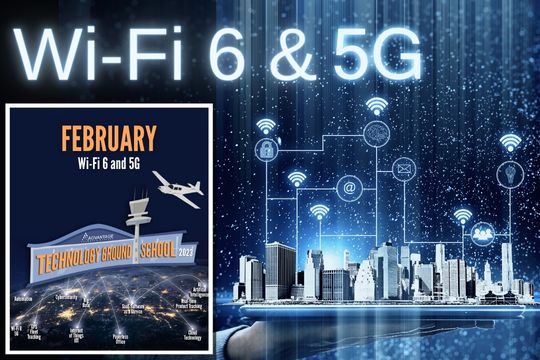
Are you a customer? Access your all-new portal by clicking here to login.

FEBRUARY TECHNOLOGY GROUND SCHOOL – Wi-Fi 6 and 5G
If you like fast connection and download speeds, then you are most likely intrigued when you hear terms like Wi-Fi 6 and 5G. However, is it necessary or worth it to invest and take advantage of the latest and greatest? Before taking any leap to invest in an upgrade, it is best to understand what exactly it is and the benefits they will bring to your organization.
We are going to break this article up into two parts. In Part One, we will discuss Wi-Fi 6, and in Part Two, we will cover 5G. Our hope is that you will gain a better understanding of each role, how it relates to the hardware purchases you make, and the processes you execute in your organization.
PART 1 – Wi-Fi 6
Before we dive in, it is best to understand what Wi-Fi is. Wi-Fi is a wireless network that allows multiple devices to share a single connection to the internet and themselves. Wi-Fi 6 is the sixth generation of wireless local area networking technology. If you would like Wi-Fi 6, then you will need to purchase a new router.
Over the years, this networking standard has evolved, producing improved versions. Wi-Fi 6 operates on the same carrier frequencies as Wi-Fi 5 (2.4GHZ and 5GHz). However, Wi-Fi 6 makes better use of the channels by allowing more data to pass through them.
Wi-Fi 6 delivers about four times the amount of wireless performance in congested settings than Wi-Fi 5. This is because of improvements to the directional antennas Multiple-in Multiple-out (MIMO) capability. Regarding frequencies, Wi-Fi 6 works with 1GHZ and 6GHz. Companies will use these frequencies in the future.
If your company uploads or downloads a lot of data, it may be worth taking a closer look at Wi-Fi 6.
Here are some ways Wi-Fi 6 can make your internet faster:
Here are some other important new features of Wi-Fi 6:
*Important Note: Wi-Fi 6 may not be compatible with all devices. Please verify before choosing to upgrade.
Now that you are informed on Wi-Fi 6 and what it offers, here are some questions you should ask yourself before deciding to deploy Wi-Fi 6:
PART 2 – 5G
5G is the 5th generation mobile network. It is the new global wireless standard after 1G, 2G, 3G and 4G, that is designed to connect virtually everyone and everything together including machines, objects, and devices. 5G wireless technology is designed to deliver higher multi-gigabit speeds, lower latency, higher reliability, and a more efficient and dependable experience to users.
Here is a brief history of the previous generations of mobile networks.
5G is designed to transform our life with its fast download speeds, capacity, and connectivity for billions of devices. A defining capability of 5G is that it is designed for forward-thinking actions and the ability to flexibly support services like virtual reality (VR), the Internet of Things (IoT), artificial intelligence (AI) and even services unknown as of today.
Besides having speeds up to 100x faster than 4G, the top 3 features businesses utilize and love about 5G include:
To take advantage of 5G, you need a device (handheld, phone, or tablet) that supports the 5G network.
Advantage Route Systems has hand-picked handheld devices that are compatible with 5G and durable in the field. You can view those options here (https://advantageroute.com/product-category/handhelds/)

Copyright © 2025 – All Rights Reserved – CLICK HERE to review our company privacy policy.